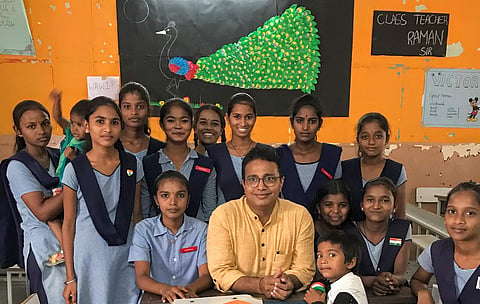

There is learning, then there is learning to learn. Jeevat is determined to focus on the latter. More particularly, they are focussed on four important aspects — self-directed learning, learning to learn skills, social-emotional learning and student engagement. So keeping these tenets in mind, Raman Asthana and Roma Tiwari, both of whom quit great corporate jobs to start Jeevat, and a group of seven volunteers put their heads together to rewrite the state syllabus of Telangana in four months flat.
First, in January 2019, they were able to do so only for classes VIII and IX, but during the lockdown, they managed to do it for classes III to VII as well. "Often, the attitude of government school children is that, 'Even if I work hard at school, what good will it do?'. What we try to create through our curriculum is hope and make them see that effort is directly proportional to hope and vice versa," says Raman and adds, "It's all about backward planning. Instead of going to Newton's Law directly, we try to make them understand why it's important." Currently, Raman is executing this project as a Teach For India fellow at two Government High Schools in Hyderabad, namely in Chaderghat and Durga Bhavani and in Khusbow Vidya Nikethan School as well.
Totally, they cater to a total of over 100 plus children. Before beginning a chapter, one week of prep work starts. And on D-Day, it all starts with open discussions, harking back to Harvard's Project Zero that focuses on effective learning. "We ask questions if we feel that the discussion is not going on the right track to gently nudge them in the right direction," says the 48-year-old. Then, the teaching begins. Now that they have gone online, the scope for introducing videos, pictures and such has only increased. The children are skilled in sketch note-taking, which makes classroom lessons that much more productive. The third week is all about practicing what has been preached. "For example, we use a cola plus methanol mix to make rockets to explain Newton's Law of Motion and the kids take over completely," explains the educationist who has worked with Mindtree and Accenture in the past. And if nothing else, they use paper airplanes. What's more? All this has been seamlessly going on online since the lockdown.
How does the team at Jeevat know that their ways are working? They measure outcomes via a simple test, once in three months, to check the children's level of self-directed learning. In the last test they conducted, on a scale of one to ten, most children ended up at six while about 30 per cent were above eight. Then are stories of pure grit like the girl who did not have a device for a month during lockdown and learned a few chapters on her own. Now, the same girl is in the top three of her class. "Even when she asked us questions, we would push her to inquire from her peers because we want to reduce our intervention," says Raman. Of course, they have started thinking about the sustainability of the project, but he is sure that once kids are back to school, it will all fall in place.
The kind of learners you will find in a class:
- Kinesthetic learners: Those who learn by participation or doing
- Reading/Writing learners: Learn best when they read or write
- Audio learners: Listening is key for these students
- Visual learners: Pictures, videos and other visual cues work
For more on them, check out jeevat.in
